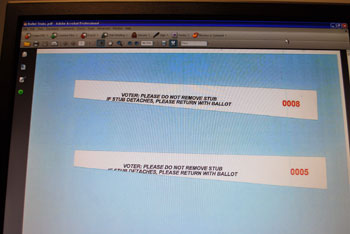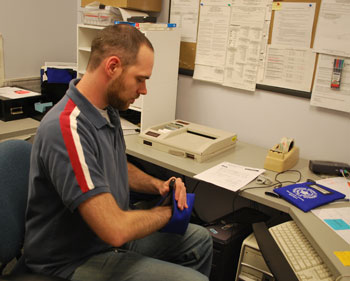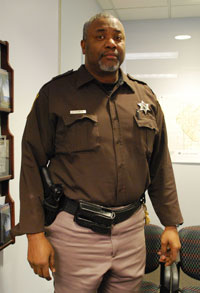Election Night in Washtenaw County
Behind the county clerk's counter on election night, inspecting poll books from the city of Ann Arbor. Only Ann Arbor uses pink paper – all others are white. No one at the clerk's office knows why. From left: Ward Beauchamp, Jason Brooks, Jen Beauchamp, Janna Parmeter. (Photo by the writer.)
It’s a few minutes after 8 p.m. on Nov. 3, and polls throughout Washtenaw County have just closed. At this point it’s fairly quiet in the offices of the county clerk, where about a half dozen people are preparing for what could be a long night of processing election returns.
Matt Yankee, the deputy clerk in charge of elections, is drinking a Diet Coke and fielding questions about what needs to be done. Jason Brooks, another deputy clerk, asks how he can help. “Why don’t you do the phones and be an Ann Arbor runner?” Yankee suggests. Brooks gives a mock salute, and almost on cue, the phone rings.
The premiere of the ABC series “V” is playing on a large screen TV in the office – a ticker of election results from metro Detroit is running along the bottom of the screen – but nobody is watching.
The Chronicle spent several hours on election night shadowing this crew, getting a glimpse of what it takes to handle the returns from 116 precincts in Washtenaw County. Though there were a few glitches – mostly problems stemming from the printing company hired to make the ballots – the evening is remarkable for its organized, systematic execution of tasks. Elections are events in which the uneventful is desired.
That’s not to say that nothing happened.
Hour One: 8-9 p.m.
The entrance to the county building in downtown Ann Arbor, at the corner of Main and Ann streets, is locked when The Chronicle arrives – later, the doors will be opened so that township clerks can get in to deliver election materials. County clerk Larry Kestenbaum lets us in, and escorts us back to the office area where results will be processed.
One of the first people we meet is Deputy Jerry Flowers, who’s sitting in the small waiting area in the clerk’s office. He tells us that for every election, there’s a security detail from the county sheriff’s department – a deputy who stays there until the county election workers are ready to go home, just in case there’s trouble.
Has there ever been any trouble? “Not really,” Flowers says. “It’s usually pretty quiet in Ann Arbor.” Frankly, it seems like a mind-numbing job, but Flowers says he volunteers for the duty and has done it for several years. For the record, we don’t observe him eating any of the Washtenaw Dairy donuts that someone brought in earlier in the day.
Early in the evening, the office hears from someone else in the sheriff’s department: Derrick Jackson, former deputy clerk in charge of elections. He calls in to ask if they’ve heard any results from the Ypsilanti Township millage vote. Jackson now works for Sheriff Jerry Clayton as director of community engagement – he’s interested in the millage because it would be used to pay for sheriff deputy patrols. [The millage fails by a narrow margin, rejected by 51.42% of voters.]
Yankee reports that in the Washtenaw County portion of Milan Township, the countywide school millage has “failed major-ly,” by a vote of 40 to 188. This will prove to be a bellwether for the evening.
Around 8:40 p.m. Conan Smith and Rebekah Warren drop by, looking for an update on results. [Smith is a county commissioner representing District 10 in Ann Arbor; Warren is a state representative for Ann Arbor's District 53, and is running for the state senate seat in District 18. That election will be held a year from now – they had no direct skin in the game for the current election.]

A scan of two ballot stubs, showing how the perforation between the main ballot and the stub was not made in a straight line. Because the stubs tore off at an angle, the voting machines had a difficult time reading the main ballot. (Photo links to larger image.)
Brooks tells them that Ann Arbor won’t be finished for a while, because of some ballot issues. County staff has been hearing all day from city and township clerks, who’ve reported that some ballots aren’t feeding into voting machines property, or aren’t being read. In Ann Arbor, for example, in several precincts there’s a one-ballot discrepancy between the machine count and the actual number of ballots. That count has to be resolved before delivering results to the county.
Brooks describes how the printer misaligned the perforation between the main ballots and the ballot stubs, which are torn off before the ballots are fed into the voting machine. “It looks like a six-year-old cut it with scissors,” he quips.
Smith, who’s executive director at the Michigan Suburbs Alliance, checks his Blackberry to see if results are in for one of his staff members, who’s running for city council in Ferndale. Kestenbaum ambles out and chats for a while, telling them that the printer will be fired. Later, he tells The Chronicle that the county might dispute the bill as well, given the problems they encountered.
Hour Two: 9-10 p.m.
Matt Yankee reports that Sylvan Township’s clerk was the first to deliver results at the front counter, beating out a disappointed Freedom Township by just a couple of minutes. Both of these townships have only one precinct each – Sylvan in particular is always “super fast,” Yankee says. And yes, it’s competitive.
Calls start coming in more frequently from random citizens and people affiliated with different campaigns. These are always answered politely, no matter how harried Brooks and Yankee are. They give the results from the county’s election website, and tell people that the best thing to do is to check that site throughout the evening. They also caution that at this point, results are preliminary, with only a small percentage of precincts reporting so far.
Brooks tells The Chronicle that he got his first call at 6:15 a.m. that morning, from someone wanting to know where to vote.
“Dancing with the Stars” is now on TV – still, no one is watching.

Matt Yankee fishes out a memory card from an official blue Washtenaw County bag. To upload election results, he'll insert the card into the machine on the desk next to him. Data is managed by the GEMS (Global Election Management System) software program. (Photo by the writer.)
Deputy clerk Jen Beauchamp is supervising the front counter, where the clerks deliver their materials. By 9:15 p.m., Bridgewater Township clerk Cindy Carver and Ann Becktel, Manchester Township’s clerk, have arrived with their ballot packets. They joke that they’re disappointed they aren’t first.
Like the other clerks, they hand over several items: Computer memory cards from each precinct, containing results from the voting machines; a report tape – a paper receipt of results printed by the voting machine; a statement of votes; and a poll book, which includes most of the information from the day, including signatures verifying the results.
The memory cards are delivered in blue nylon bags with the Washtenaw County seal printed in white. Other materials arrive in one of two envelopes, marked for the county clerk or the county board of canvassers, which will review the results on Thursday, handle any outstanding issues, and validate the results.
Throughout the evening, Yankee processes memory cards, uploading the information on them into the software program GEMS (Global Election Management System). A couple of times, Yankee encounters memory cards that have been wiped clean. This requires that he get the poll book and enter the results manually.
The Ann Arbor city clerk’s office reports that they’ve finished up several precincts, so Brooks heads over to pick up whatever is ready. Since city hall is just a couple of blocks away, the county staff is willing to make several of these runs so that they can process the results incrementally throughout the night. Ann Arbor, with nearly 50 precincts, is by far the largest in the county.
Hour Three: 10-11 p.m.
It’s 10:15 p.m. and about 20% of the precincts have reported in. The margin against the countywide school millage is widening – nearly 58% have voted against it, but Yankee notes that they haven’t yet tallied all of Ann Arbor, and haven’t heard from Pittsfield or Scio townships.
Several other townships trickle in. Brooks has been trying to reach the clerk in London Township with a question about some information they need – no one is answering the phone, and he figures they’ve already gone home. London Township is located in Monroe County, but some residents there live in the Milan school district and were voting on the Washtenaw school millage. Brooks can’t reach anyone in the Monroe County clerk’s office either. They’ll have to wait until Wednesday morning, Yankee says.
At 10:50 p.m., Ypsilanti Township clerk Karen Lovejoy Roe – a former county commissioner – is at the counter, looking tired. It’s been a long day.
Near 11 p.m., Kestenbaum observes that with 45% of the precincts now in, the school millage is down by more than 4,000 votes. “I can’t see how it can make it now,” he says.
Hour Four: 11 p.m.-midnight
Outside calls are now brisk, from people wanting to know results. Pittsfield Township has reported in, and Ann Arbor has finished up most of its precincts. That leaves Scio Township as the largest municipality that hasn’t yet reported in.
This will be an early night, relatively speaking. A year ago, heavy turnout for the presidential race meant that the county elections staff worked through the night – Brooks said he was there until 4 a.m.

Matt Yankee, at the computer, shows Jason Brooks how to enter data into the election software program. Both are deputy clerks with Washtenaw County.
But by 11:30 p.m. on Tuesday, things have slowed down considerably. Brooks goes into the office where Yankee is uploading memory cards. “Jen told me to bounce,” Brooks says, referring to Jen Beauchamp, the deputy clerk who’s been staffing the front counter where clerks are dropping off results.
Yankee plans to stay a while longer, which means he won’t be there when Brooks returns in the morning. He asks Brooks to follow up on some outstanding issues on Wednesday – the information they need from London Township, for one thing – and shows him how to enter the data into the GEMS program, when he gets it.
With that, Brooks takes off. “See you, Matt,” he says, “but hopefully not tomorrow.” If they cross paths in the morning, it will mean that something unexpected happened.
At that point, Yankee and Kestenbaum were confident there’d be no 11th-hour surprises – there weren’t, Yankee told The Chronicle on Wednesday. At midnight, with about 75% of the precincts reporting, the results had solidified – including the defeat of the county school millage.
And in the Washtenaw Dairy box, six donuts remained.





Hi Dave: In response to your photo caption about the City of Ann Arbor’s pink pollbooks: we color-code all of our paperwork to match our three envelopes. All pink documents and paperwork go in the pink envelope to the County Clerk. Yellow documents go in the yellow envelope to the City Clerk and blue goes to the Board of Canvassers. After a long day (15+ hours for pollworkers), our system helps ensure that everything is accounted for and sent to the correct place. Our pollworkers think our color-coded system is great.